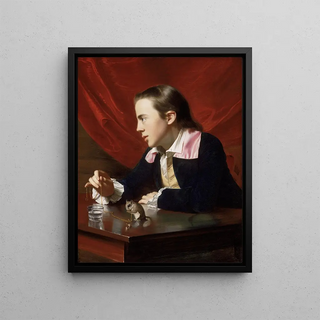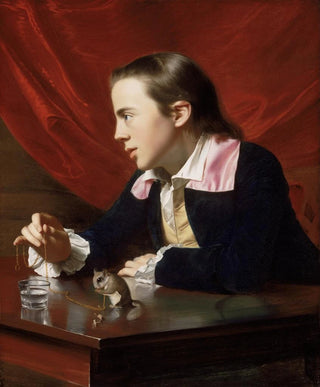Art print | A boy with a flying squirrel Henry Pelham - John Singleton Copley


View from behind

Frame (optional)
In the fascinating universe of art, some works transcend their era to become timeless witnesses to humanity. "A Boy with a Flying Squirrel Henry Pelham" by John Singleton Copley is a perfect example. This painting, which captures juvenile innocence and natural curiosity, immerses us in a world where childhood and nature meet with rare delicacy. The piece, both intimate and evocative, invites us to explore the emotions and thoughts that animate the young boy, while offering a glimpse into the harmonious relationship between man and animal. It is a work that, beyond its aesthetic appeal, raises questions about childhood, freedom, and the ephemeral beauty of life.
Style and uniqueness of the work
Copley's style is distinguished by its striking realism and meticulous attention to detail. In "A Boy with a Flying Squirrel Henry Pelham," every brushstroke seems imbued with life, giving the work an almost tactile dimension. The boy's face, with its delicate and expressive features, is highlighted by subtle lighting that emphasizes the innocence of his gaze. The squirrel, with its silky fur and lively movements, adds dynamism to the composition, creating a visual dialogue between the child and the animal. This painting does not merely depict a scene; it evokes an atmosphere, a palpable emotion that transports the viewer to a suspended moment in time. The color palette, both soft and vibrant, contributes to this ambiance, making the artwork even more captivating.
The artist and his influence
John Singleton Copley, an emblematic figure of the 18th century, knew how to mark his era with his innovative approach to painting. Born in Boston, he established himself as one of the greatest portraitists of his time, but his talent was not limited to this genre. Copley explored various themes, ranging from mythology to everyday life, while incorporating elements of his American environment. His influence extends well beyond his contemporaries,

Matte finish

View from behind

Frame (optional)
In the fascinating universe of art, some works transcend their era to become timeless witnesses to humanity. "A Boy with a Flying Squirrel Henry Pelham" by John Singleton Copley is a perfect example. This painting, which captures juvenile innocence and natural curiosity, immerses us in a world where childhood and nature meet with rare delicacy. The piece, both intimate and evocative, invites us to explore the emotions and thoughts that animate the young boy, while offering a glimpse into the harmonious relationship between man and animal. It is a work that, beyond its aesthetic appeal, raises questions about childhood, freedom, and the ephemeral beauty of life.
Style and uniqueness of the work
Copley's style is distinguished by its striking realism and meticulous attention to detail. In "A Boy with a Flying Squirrel Henry Pelham," every brushstroke seems imbued with life, giving the work an almost tactile dimension. The boy's face, with its delicate and expressive features, is highlighted by subtle lighting that emphasizes the innocence of his gaze. The squirrel, with its silky fur and lively movements, adds dynamism to the composition, creating a visual dialogue between the child and the animal. This painting does not merely depict a scene; it evokes an atmosphere, a palpable emotion that transports the viewer to a suspended moment in time. The color palette, both soft and vibrant, contributes to this ambiance, making the artwork even more captivating.
The artist and his influence
John Singleton Copley, an emblematic figure of the 18th century, knew how to mark his era with his innovative approach to painting. Born in Boston, he established himself as one of the greatest portraitists of his time, but his talent was not limited to this genre. Copley explored various themes, ranging from mythology to everyday life, while incorporating elements of his American environment. His influence extends well beyond his contemporaries,






